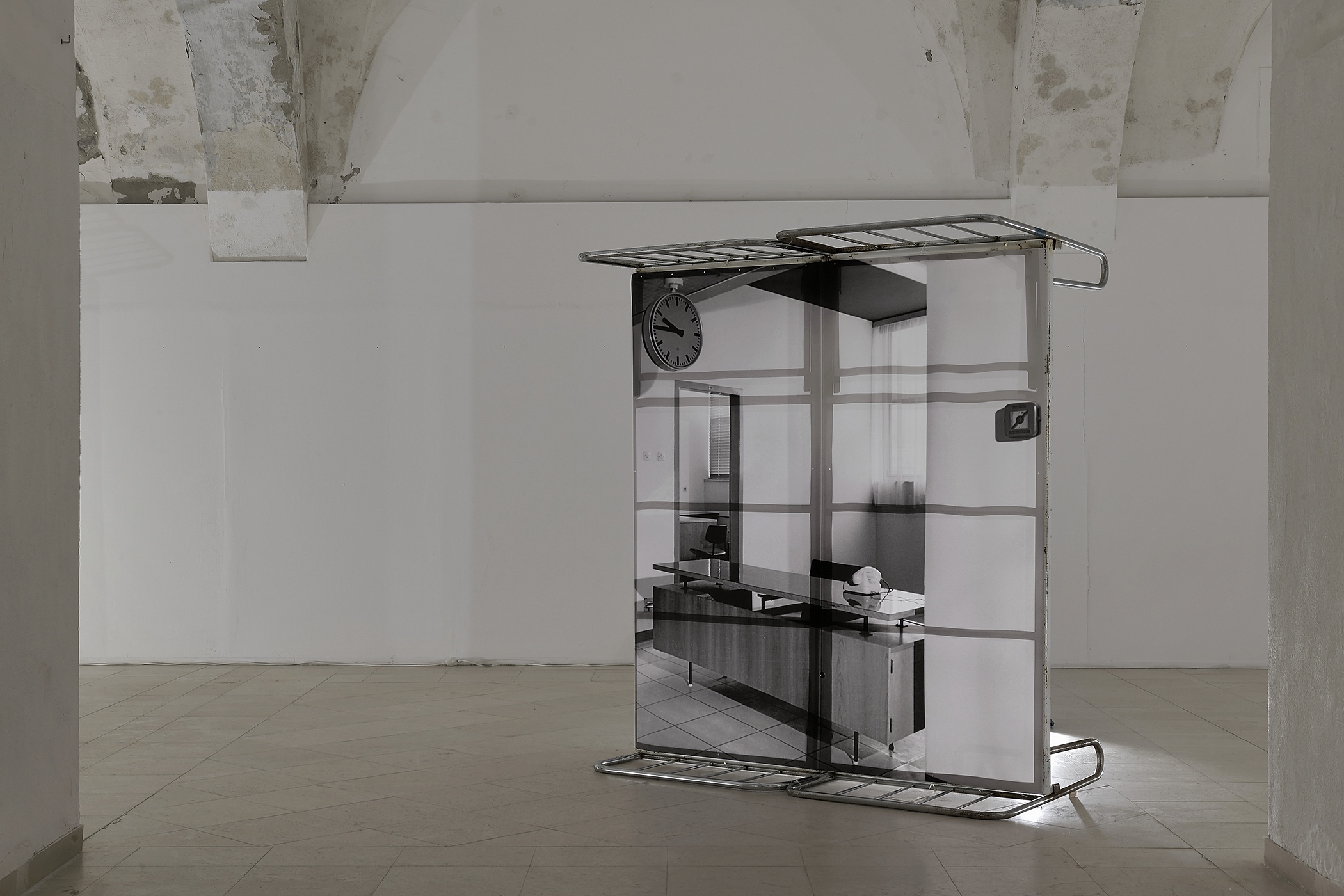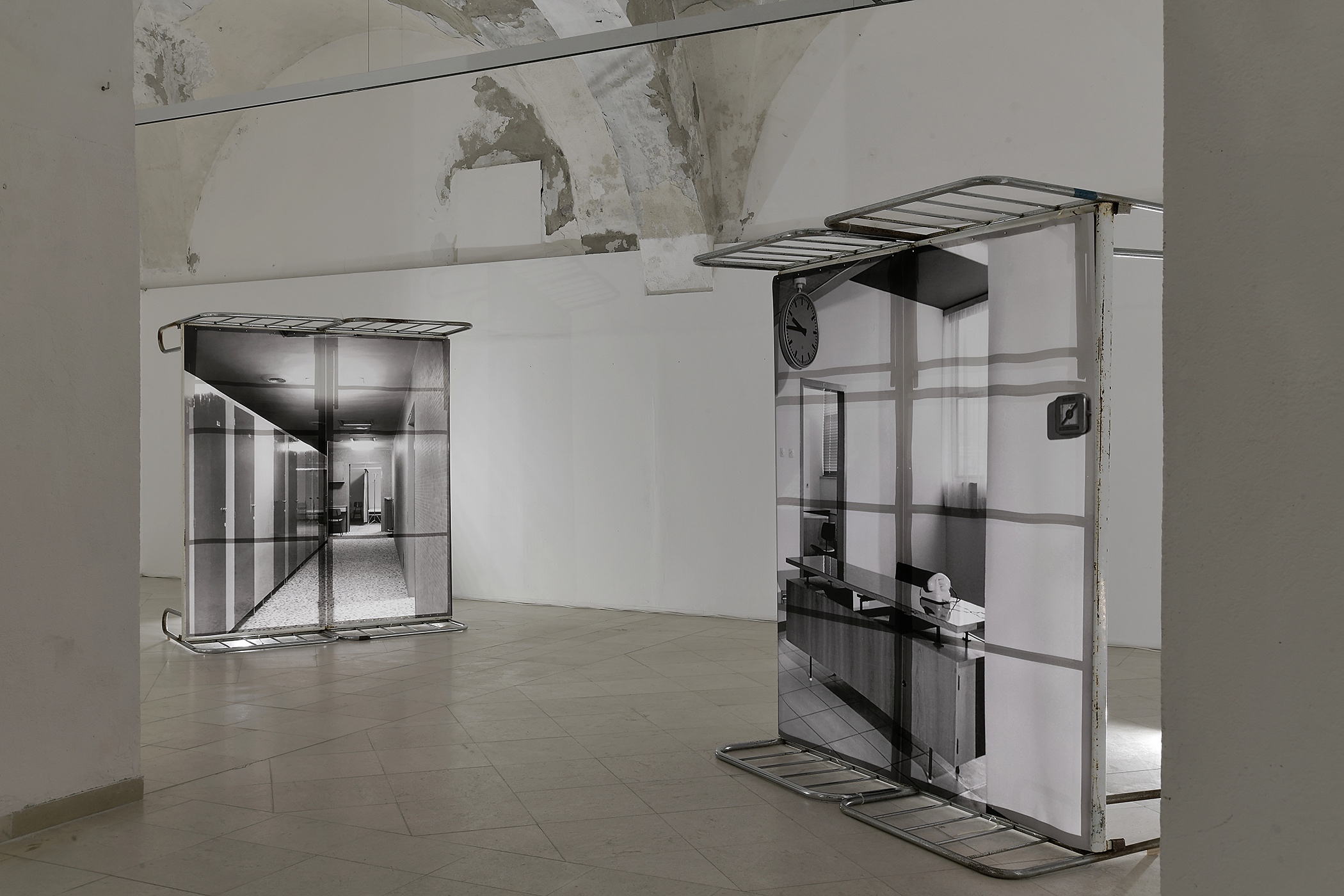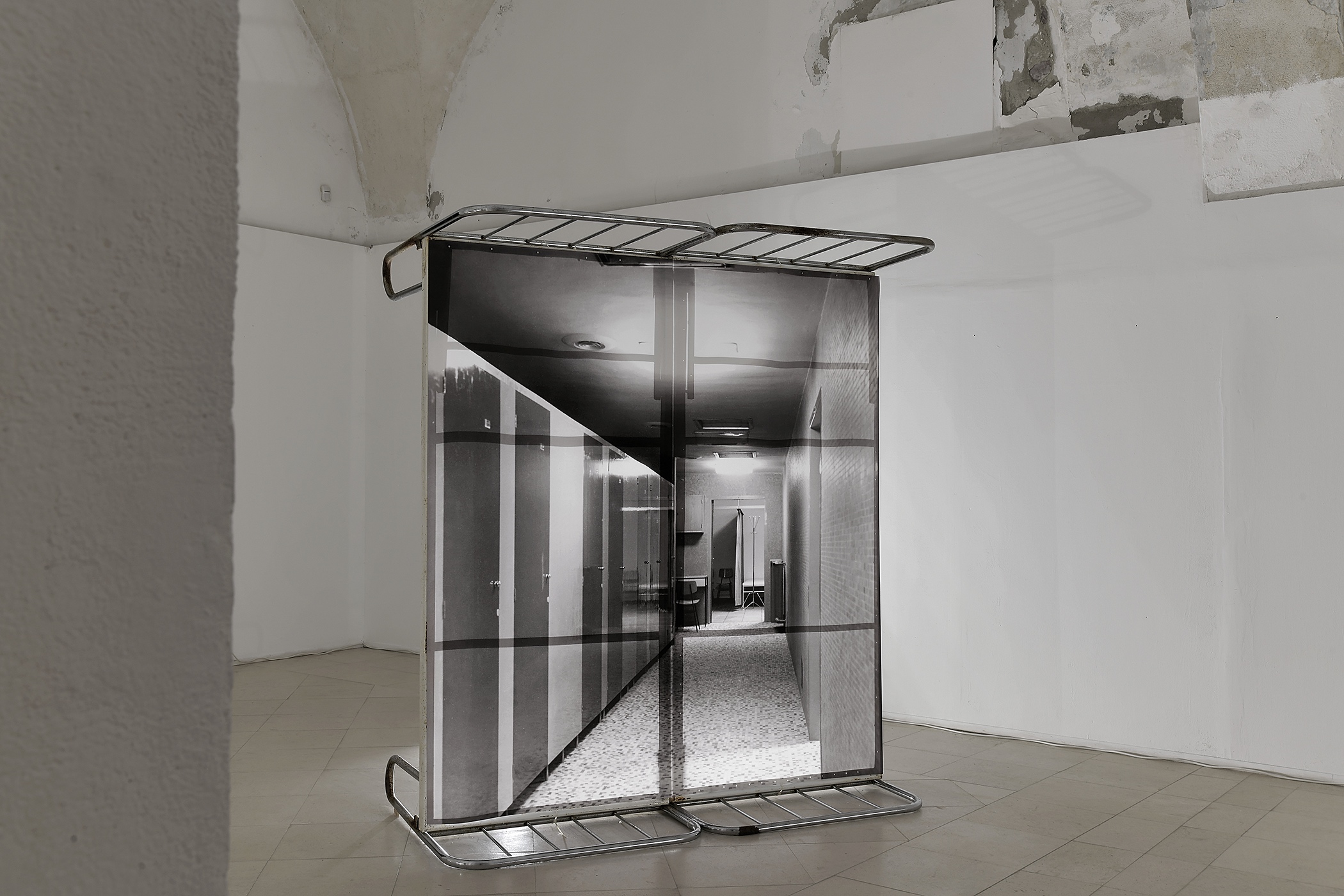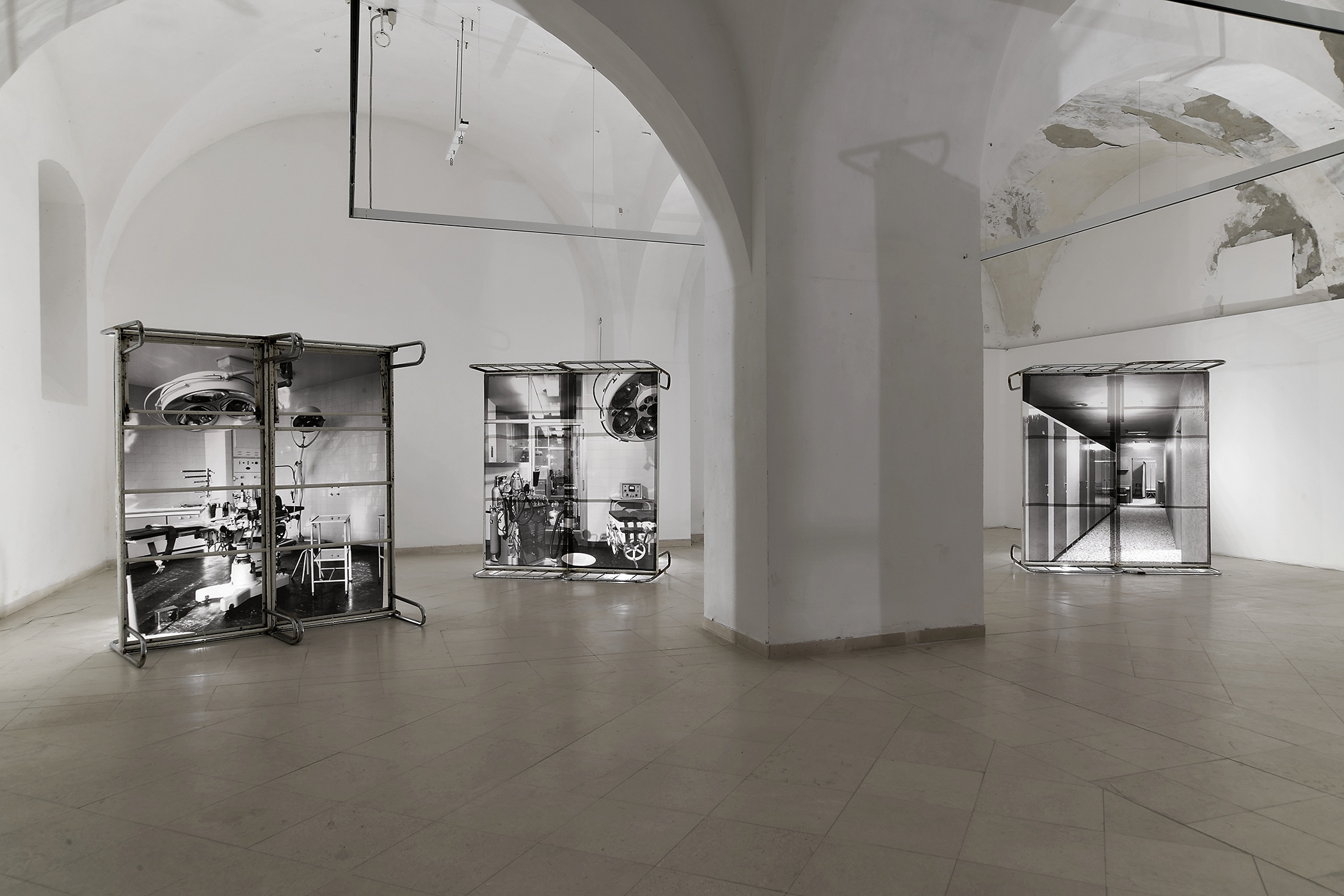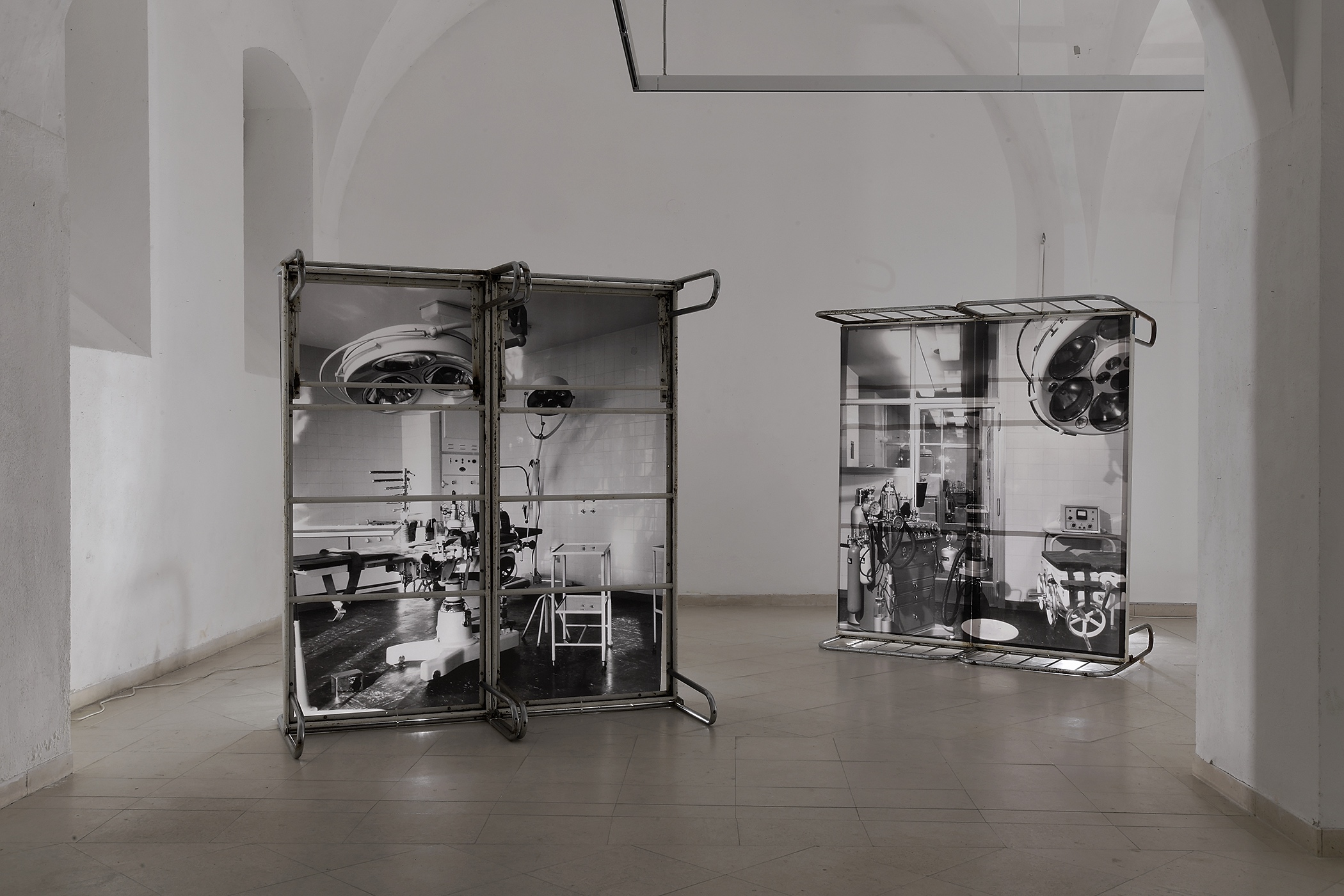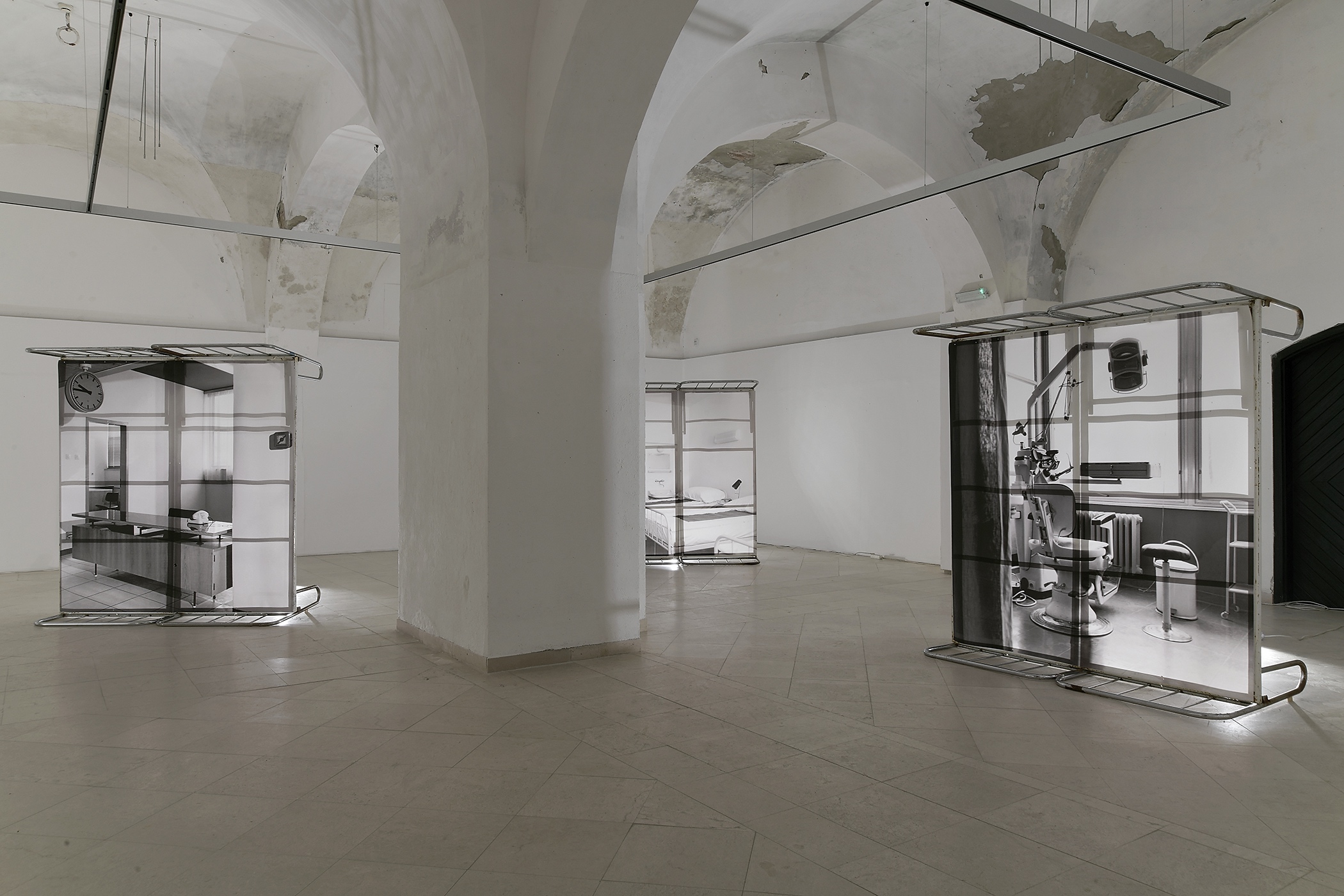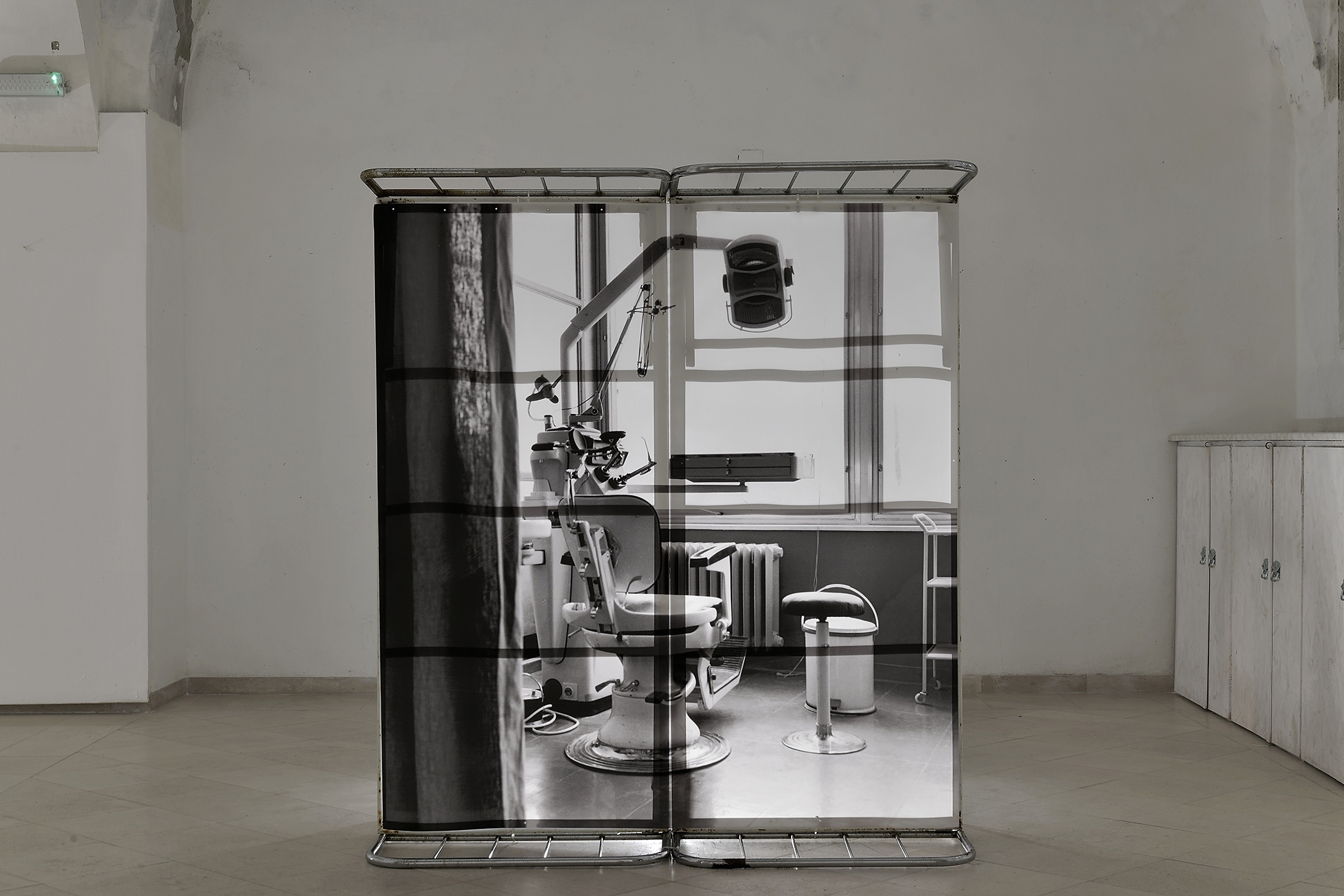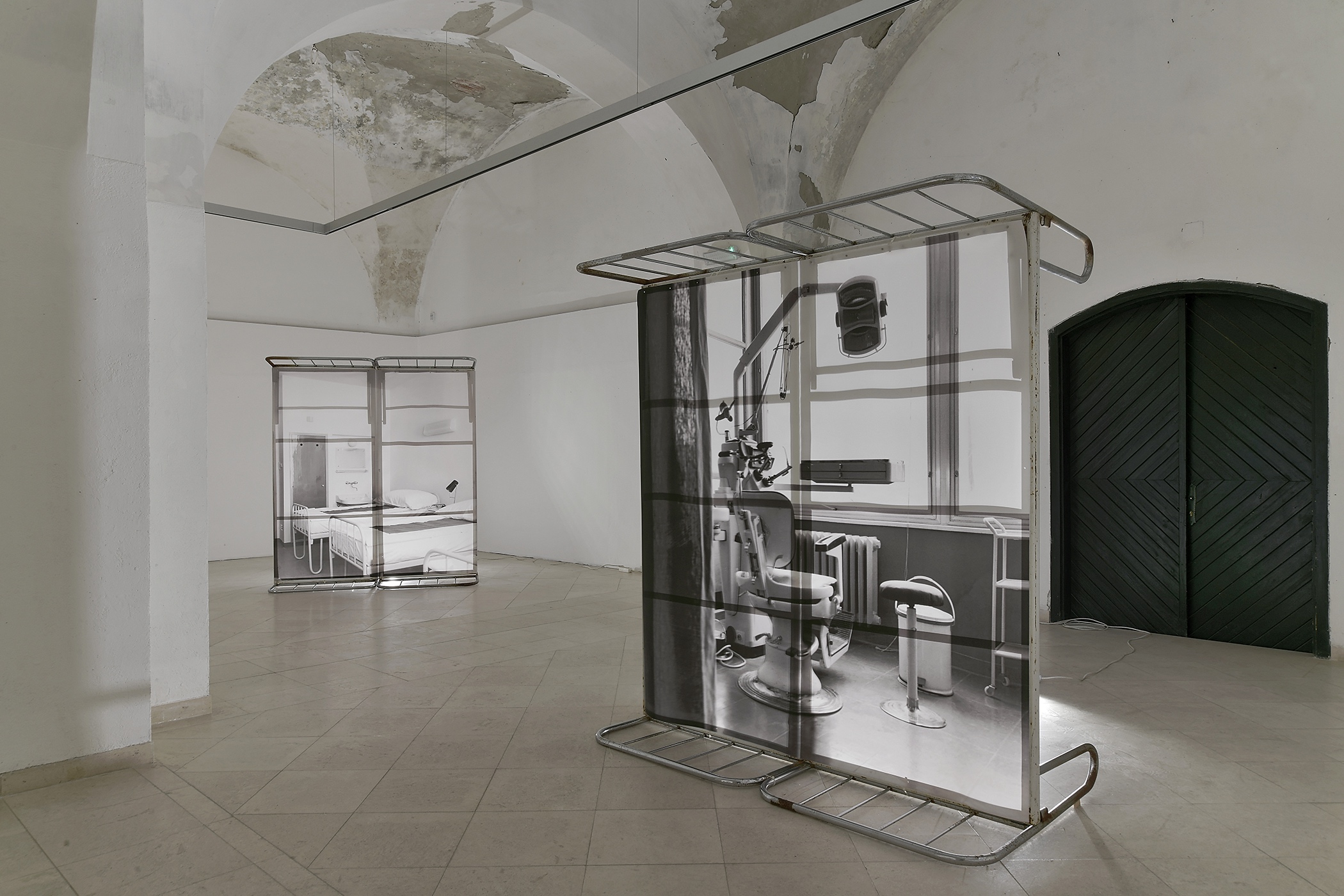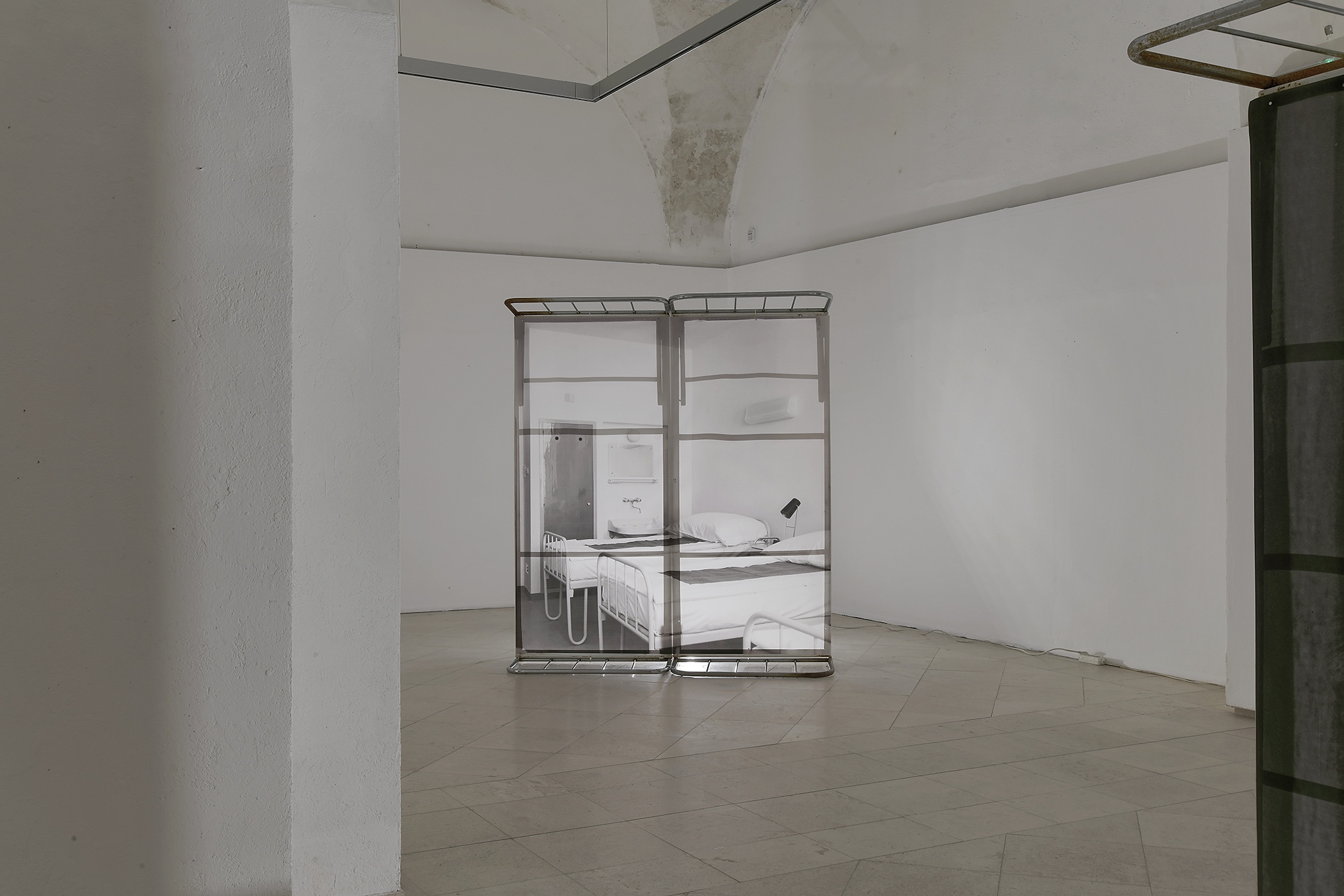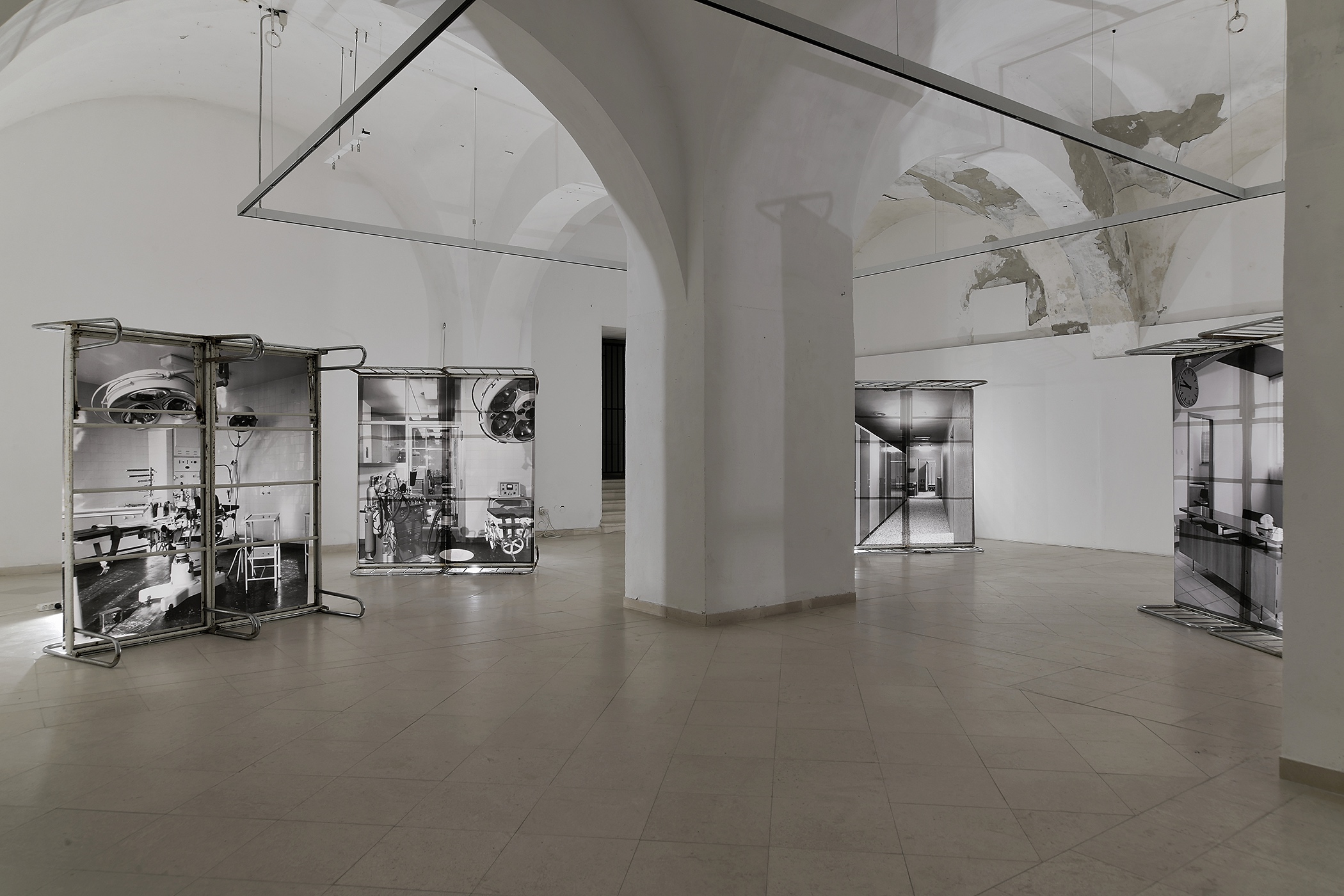Branka Benčić
Memory Supports
The exhibition by Viktor Popović at the Waldinger Gallery – Osijek City Galleries represents a continuity of the artist’s research directed to the overview of the location from his immediate vicinity, Split 3, the part of the city he grew up in and where he lives, indicating the memory of a scene that can exist registered in his sight. The works making up the project Untitled (Archive ST3) and their continuity in Untitled (Archive ST3: Military Hospital) represent visual research which has by now become a long-term subject of the artist’s interest. Different displays and interpretations of the works in this multilayered project have been realized in various media and formats, in different museums, and galleries, i.e. exhibiting contexts. Within recent reinterpretations of the project, Viktor directs his look on selected scenes from the past of the military hospital as a place through which it is possible to frame a series of social transformations or economic relations, current situations, and actual positions in the framework of the city of Split or Croatia.
The central point of the exhibition is the construction of several ready-made objects, used hospital beds with which, using a simple intervention and artistic gesture, the artist constructs a complex and multi-layered installation. It is a group of large format objects made up of several pairs of vertically placed old hospital beds, as freestanding objects displayed in space as to create a certain dramaturgy of a staged theatre of objects and direct our view and choreograph our movements through the gallery space. These beds are not only props of the past in the role of artistic installation, but at the same, they represent some kind of constructions, frames for photographs, bearers of a certain memory manifested as large format digital prints of archive black and white photographs from the Collection of Photographs of the City Museum of Split, representing details of the hospital’s interior, inventory and medical equipment. The photographs represent a clinical view, distanced and cold, and include a temporal distance from the represented subjects, pointing out the relationship between place and document. Untitled (Archive ST3: Military Hospital) brings together forms of representation according to which the artist is trying to establish a dialogue, adopting various dispositifs – photographic representation and the object, i.e. ready-made objects, their formal, esthetic, conceptual, and technical preconditions.
By framing a fragment of space and time, the poetics and politics of this installation frame the place and identity of a specific location. The artist questions issues of collective memory and social and political reality within the installation, which equally points to the state and role of the object in its original situation and the new context, transferring complex relations of layers of official history and the personal, as well as the memory of the community. The exhibition, therefore, does not reposition only the issues of nostalgia and memory but also a network of different relationships – issues of the utopian potential of modernity and progress, the building of the city, the public infrastructure, the public good, and the future and identity of cities. In that sense, Viktor Popović’s work is much more than just a visual representation of the space of the ex-military hospital. By using archive photography and worn-out inventory and blending, like in a double exposition, this view from the past and his commentary on the present, this very image of nostalgia, as Svetlana Boym points out in The Future of Nostalgia, is the image of double exposition – a collision of the past and the present, illusion, and reality.1
By establishing connections with the past, mainly through taking over archive photographs and the presence of the very objects we recognize as found, authentic, hospital beds, in the role of memory tools, Viktor Popović intertwines spatially and temporally loosely connected moments, trying to unravel the social and collective “remembering of the past”. Whether we had a direct meeting with the past based on our own or through mediated memories, through storytelling, models of oral tradition, film, photography, opinions, and positions towards history are considered again and reshaped in the present. In that way, the social and collective “remembering of the past” is not just the result of facts and direct experience. It functions as a narrative construction subject to individual questioning. It is a process of reflexive understanding of the past, on grounds of personal construction and reinterpretation of (auto)biographical memory. With the establishment of a connection with the past, mainly using images as memory tools, artists are trying to understand and define the times we live in. The processes of analysis of fixed understanding point to issues encouraged by ideas whose meaning is articulated in the gap between the past and the present.
Memory Supports
The exhibition by Viktor Popović at the Waldinger Gallery – Osijek City Galleries represents a continuity of the artist’s research directed to the overview of the location from his immediate vicinity, Split 3, the part of the city he grew up in and where he lives, indicating the memory of a scene that can exist registered in his sight. The works making up the project Untitled (Archive ST3) and their continuity in Untitled (Archive ST3: Military Hospital) represent visual research which has by now become a long-term subject of the artist’s interest. Different displays and interpretations of the works in this multilayered project have been realized in various media and formats, in different museums, and galleries, i.e. exhibiting contexts. Within recent reinterpretations of the project, Viktor directs his look on selected scenes from the past of the military hospital as a place through which it is possible to frame a series of social transformations or economic relations, current situations, and actual positions in the framework of the city of Split or Croatia.
The central point of the exhibition is the construction of several ready-made objects, used hospital beds with which, using a simple intervention and artistic gesture, the artist constructs a complex and multi-layered installation. It is a group of large format objects made up of several pairs of vertically placed old hospital beds, as freestanding objects displayed in space as to create a certain dramaturgy of a staged theatre of objects and direct our view and choreograph our movements through the gallery space. These beds are not only props of the past in the role of artistic installation, but at the same, they represent some kind of constructions, frames for photographs, bearers of a certain memory manifested as large format digital prints of archive black and white photographs from the Collection of Photographs of the City Museum of Split, representing details of the hospital’s interior, inventory and medical equipment. The photographs represent a clinical view, distanced and cold, and include a temporal distance from the represented subjects, pointing out the relationship between place and document. Untitled (Archive ST3: Military Hospital) brings together forms of representation according to which the artist is trying to establish a dialogue, adopting various dispositifs – photographic representation and the object, i.e. ready-made objects, their formal, esthetic, conceptual, and technical preconditions.
By framing a fragment of space and time, the poetics and politics of this installation frame the place and identity of a specific location. The artist questions issues of collective memory and social and political reality within the installation, which equally points to the state and role of the object in its original situation and the new context, transferring complex relations of layers of official history and the personal, as well as the memory of the community. The exhibition, therefore, does not reposition only the issues of nostalgia and memory but also a network of different relationships – issues of the utopian potential of modernity and progress, the building of the city, the public infrastructure, the public good, and the future and identity of cities. In that sense, Viktor Popović’s work is much more than just a visual representation of the space of the ex-military hospital. By using archive photography and worn-out inventory and blending, like in a double exposition, this view from the past and his commentary on the present, this very image of nostalgia, as Svetlana Boym points out in The Future of Nostalgia, is the image of double exposition – a collision of the past and the present, illusion, and reality.1
By establishing connections with the past, mainly through taking over archive photographs and the presence of the very objects we recognize as found, authentic, hospital beds, in the role of memory tools, Viktor Popović intertwines spatially and temporally loosely connected moments, trying to unravel the social and collective “remembering of the past”. Whether we had a direct meeting with the past based on our own or through mediated memories, through storytelling, models of oral tradition, film, photography, opinions, and positions towards history are considered again and reshaped in the present. In that way, the social and collective “remembering of the past” is not just the result of facts and direct experience. It functions as a narrative construction subject to individual questioning. It is a process of reflexive understanding of the past, on grounds of personal construction and reinterpretation of (auto)biographical memory. With the establishment of a connection with the past, mainly using images as memory tools, artists are trying to understand and define the times we live in. The processes of analysis of fixed understanding point to issues encouraged by ideas whose meaning is articulated in the gap between the past and the present.
- Svetlana Boym: The Future of Nostalgia, Basic Books, New York, 2001.
2019
Untitled (Archive ST3: Military Hospital)
solo exhibition
Waldinger Gallery – Osijek City Galleries, Osijek, Croatia
October 23 – November 24, 2019
curator:
Branka Benčić
—
works exhibited:
1-6
Untitled (Archive ST3: Military Hospital), 2019
digital prints on canvas, used hospital beds
each print 185,5 x 173 cm
archival photographs: City Museum of Split, Collection of Photographs (photographer: Ante Roca)
—
photo credits:
Viktor Popović
solo exhibition
Waldinger Gallery – Osijek City Galleries, Osijek, Croatia
October 23 – November 24, 2019
curator:
Branka Benčić
—
works exhibited:
1-6
Untitled (Archive ST3: Military Hospital), 2019
digital prints on canvas, used hospital beds
each print 185,5 x 173 cm
archival photographs: City Museum of Split, Collection of Photographs (photographer: Ante Roca)
—
photo credits:
Viktor Popović
14.04.2025.
© 2025 Viktor Popović
- Viktor Popović
- Exhibitions
- 2024 | Waldinger Gallery, Osijek
- 2024 | Apoteka – Space for Contemporary Art, Vodnjan
- 2024 | Technical Museum Nikola Tesla, Zagreb
- 2024 | Croatian Home, Split
- 2023 | Josip Račić Gallery, Zagreb
- 2023 | Filodrammatica Gallery, Rijeka
- 2023 | Ravne Gallery, Ravne na Koroškem
- 2023 | C24 Gallery, New York
- 2022 | A:D: Curatorial, Berlin
- 2021 | Faculty of Humanities and Social Sciences, Split
- 2021 | Cultural Institution Kula Gallery, Split
- 2020 | Health Center, Omiš
- 2020 | Armory Show, New York
- 2019 | Waldinger Gallery, Osijek
- 2019 | University Gallery Vasko Lipovac, Split
- 2019 | Museum of Fine Arts, Split
- 2018 | AŽ Gallery – Žitnjak Studios, Zagreb
- 2018 | C24 Gallery, New York
- 2017 | Multimedia Cultural Center, Split
- 2017 | Museum of Contemporary Art, Zagreb
- 2017 | Cukrarna Palace, Ljubljana
- 2015 | Salon Galić Gallery, Split
- 2015 | School Gallery, Split
- 2014 | MAP – Meeting Art Place, Brela
- 2014 | Billboard, Cista Provo
- 2013 | Split City Museum Gallery, Split
- 2013 | Lauba – People and Art House, Zagreb
- 2011 | Goli&Bosi Hostel, Split
- 2011 | City Lodge, Zadar
- 2011 | Museum of Fine Arts, Split
- 2010 | Richter Collection, Zagreb
- 2010 | St. Toma Gallery, Rovinj
- 2010 | Museum of Contemporary Art, Zagreb
- 2009 | Fonticus Gallery, Grožnjan
- 2008 | Mestrović Pavillion, Zagreb
- 2008 | The Old Printshop, Pula
- 2008 | Marganovo / Hartera, Rijeka
- 2008 | Glyptotheque, Zagreb
- 2008 | Multimedia Cultural Center, Split
- 2007 | Bačvice Aquarium, Split
- 2006 | Portland Art Center, Portland
- 2006 | City Reading Room, Komiža
- 2006 | Glyptotheque, Zagreb
- Projects
- 2024 | Untitled (Archive Fine Arts Museum)
- 2024 | Untitled (Archive Pharmacy)
- 2024 | Untitled (Archive Lynotipe)
- 2024 | Untitled (Archive Croatian Home)
- 2023 | Untitled (Archive Vranyczany-Dobrinović Palace)
- 2023 | Untitled (Archive Filodrammatica)
- 2023 | Untitled (Archive Ravne Steelworks)
- 2023 | Untitled (Monuments Archives)
- 2022 | Untitled (Archive Aperto Raum)
- 2021 | Untitled (Archive ST3: Content)
- 2021 | Untitled (Archive ST3: Content)
- 2020 | Untitled (Archive Omiš: Health Center)
- 2020 | Untitled (Archive Zenčišće)
- 2019 | Untitled (Archive ST3: Military Hospital)
- 2018 | Untitled (Archive ST3: Content)
- 2018 | Untitled (Archive ST3: Military Hospital)
- 2017 | Untitled (Archive ST3: Military Hospital)
- 2017 | Untitled
- 2015 | Untitled (Archive ST3)
- 2015 | Untitled
- 2014 | Untitled
- 2013 | Untitled
- 2011-2013 | Untitled
- 2011-2013 | Untitled
- 2007-2013 | Untitled
- 2007-2011 | Untitled
- 2010 | Untitled
- 2010 | Untitled
- 2009 | Untitled
- 2008 | Untitled
- 2008 | Untitled
- 2007 | Untitled
- 2007 | Untitled
- 2006 | Untitled
- 2006 | Untitled
- 2006 | Untitled
- Essays
- 2024 | Dalibor Prančević
- 2024 | Julija Gracin and Nevena Štokić
- 2024 | Ana Petković Basletić
- 2023 | Branko Franceschi
- 2023 | Sonja Jankov
- 2023 | Davor Mišković
- 2023 | Jernej Kožar
- 2022 | Adeline de Monseignat
- 2021 | Dalibor Prančević
- 2021 | Jasminka Babić
- 2020 | Jasminka Babić
- 2019 | Branka Benčić
- 2019 | Branko Franceschi
- 2017 | Nataša Ivančević
- 2017 | Jasminka Babić
- 2015 | Jasminka Babić
- 2014 | Jasminka Babić
- 2013 | Jasminka Babić
- 2012 | Ksenija Orelj and Sabina Salomon
- 2011 | Jasminka Babić
- 2008 | Ksenija Orelj
- 2007 | Klaudio Štefančić
- 2004 | Jasminka Babić
- 2004 | Dalibor Prančević
- CV
- Contact
- Sitemap
© 2025 Viktor Popović
